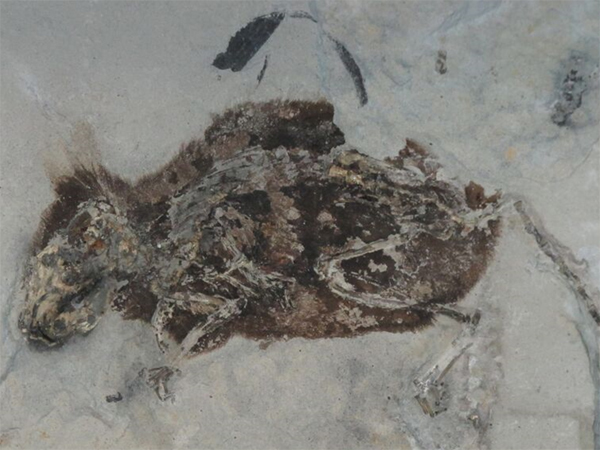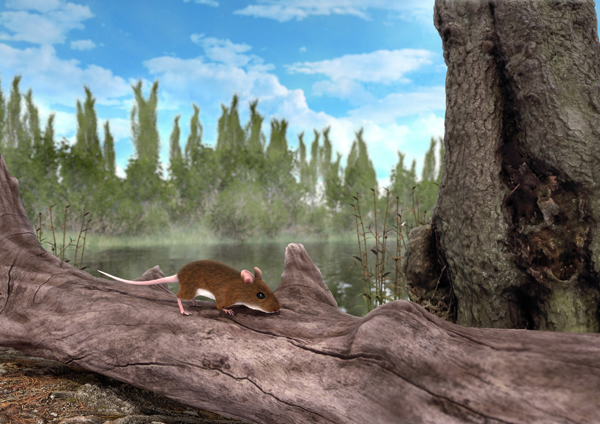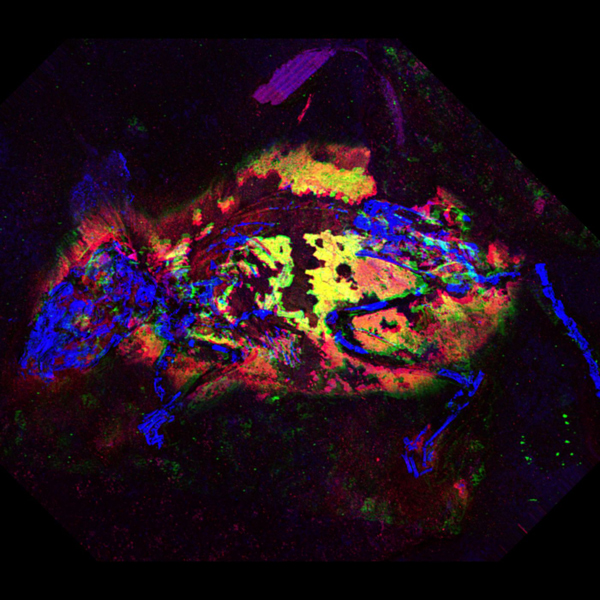Ancient Mouse Reveals a Colourful Mammalian Heritage
Many mammals are brightly coloured, we have golden marmosets, red pandas and of course, black and white zebras. The evolutionary use of colour within the Kingdom Animalia has long held the fascination of scientists, academics and philosophers. This week, an international team of researchers led by members of The University of Manchester have published a new study revealing the evidence of colourful pigments in the remains of an ancient mouse.
The Fossilised Remains of a Prehistoric Mouse
Picture credit: The University of Manchester
Establishing the Colouration of Extinct Animals
Writing in the journal “Nature Communications”, this work marks a major breakthrough in our ability to define colour pigments within the fossilised remains of long extinct animals and emphasises the role colour plays in the evolution of life on our planet. The paper entitled “Pheomelanin pigment remnants mapped in fossils of an extinct mammal”, outlines the use of X-ray imaging on the 3 million-year-old fossils in order to unravel the story of key pigments in ancient creatures and demonstrates how we might recognise the chemical signatures of specific red pigments in extinct animals to determine how they evolved.
Professor Phil Manning, (University of Manchester), the lead palaeontologist involved in this study explained:
“The fossils we have studied have the vast potential to unlock many secrets of the original organism. We can reconstruct key facets from life, death and the subsequent events impacting preservation before and after burial. To unpick this complicated fossil chemical archive requires an interdisciplinary team to combine their efforts to crack this problem. In doing this, we unlock much more than just palaeontological information.”
Co-author, Professor Roy Wogelius, from the University’s School of Earth and Environmental Sciences, added:
“This was a painstaking effort involving physics, palaeontology, organic chemistry, and geochemistry. By working as a team, we were able, for the first time, to discover chemical traces of red pigment in fossil animal material. We understand now what to look for in the future and our hope is that these results will mean that we can become more confident in reconstructing extinct animals and thereby add another dimension to the study of evolution.”
This exciting, collaborative effort from numerous scientific disciplines reveals that within fossils with exceptionally preserved soft tissues, evidence of black pigmentation can be identified, but furthermore, traces of the much more elusive red animal pigment may be found. The chemical residue of black pigment, which colours such animals as crows, was first resolved by this team in a previous study nearly ten years ago. However, the red pigment, characteristic of animals such as foxes and red pandas, is far less stable over geological time and proved much more difficult to detect.
Apodemus atavus Life Reconstruction
Picture credit: The University of Manchester
Professor Wogelius went on to say:
“We had data which suggested red pigment residue was present in several fossils, but there was no useful data available to compare this to pigmentation in modern organisms. So, we needed to devote several years to analysing modern tissue before we could go back and review our results from some amazing fossil specimens. In the end, we were able to prove that detailed chemical analysis can resolve such pigment residue, but along the way we learned so much more about the chemistry of pigmentation throughout the animal kingdom.”
Shining a Light on Pigmentation Thanks to the Stanford Synchrotron Radiation Lightsource
To unlock the hidden data within the ancient mouse fossil material, the Manchester-based scientists collaborated with researchers at some of the brightest sources of light on the planet, using synchrotron radiation at the Stanford Synchrotron Radiation Lightsource (USA), and also at the Diamond Light Source (located in Oxfordshire), to bombard the fossils with intense X-rays. It is the interaction of these X-rays with the chemistry of these fossils that enabled the team to be the first to recognise the chemistry of red pigmentation (pheomelanin), in fur from the exceptionally well-preserved remains of a mouse that scuttled about in the Pliocene Epoch (Apodemus atavus).
The key to the study was identifying trace metals incorporated by ancient organisms into their soft tissues and comparing these to the modes of incorporation into living species. The chemistry shows that the trace metals in the mouse fur are bonded to organic chemicals in exactly the same way that these metals are bonded to organic pigments in animals with high concentrations of red pigment in their tissue.
In order to confirm the team’s findings, modern comparison standards were analysed by synchrotron radiation and by specialists in pigment chemistry based at the Fujita Health University in Japan.
A False Colour Image of the Fossilised Mouse
Picture credit: The University of Manchester
Ancient Mouse Provides Insights into Many Scientific Disciplines
Summarising the significance of this research Professor Manning stated:
“Palaeontology offers research that is more than relevant to our everyday life. Information gleaned from the fossil record is influencing multiple fields, including; climate research, the burial of biowaste and radwaste, the measure of environmental impact of oil spills on living species with techniques developed on fossil organisms. Whilst our research is firmly anchored in the past, we set our sights on its application to the future.”
The scientific paper: “Pheomelanin pigment remnants mapped in fossils of an extinct mammal” by Phillip L. Manning, Nicholas P. Edwards, Uwe Bergmann, Jennifer Anné, William I. Sellers, Arjen van Veelen, Dimosthenis Sokaras, Victoria M. Egerton, Roberto Alonso-Mori, Konstantin Ignatyev, Bart E. van Dongen, Kazumasa Wakamatsu, Shosuke Ito, Fabien Knoll & Roy A. Wogelius and published in Nature Communications
Everything Dinosaur acknowledges the assistance of a press release from Manchester University in the compilation of this article.
Visit the Everything Dinosaur website: Everything Dinosaur.









Leave A Comment